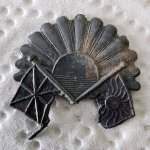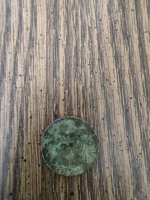DeepseekerADS
Gold Member
- Mar 3, 2013
- 14,880
- 21,725
- Detector(s) used
- CTX, Excal II, EQ800, Fisher 1260X, Tesoro Royal Sabre, Tejon, Garrett ADSIII, Carrot, Stealth 920iX, Keene A52
- Primary Interest:
- Other
Jason Richards
During a natural disaster or war, food shortages and
lack of natural gas or electricity for cooking requires
a great deal of improvisation and reliance upon
back-to-basics cooking techniques used
by our forefathers in order to survive.
In an emergency it helps to know what to do with
all the wheat, rice, cornmeal, sugar, molasses,
vegetable oil and dried beans, milk, fruits and
vegetables which you've wisely cached along
with firewood or cooking fuel.
Recipes for the modern kitchen with a temperature-controlled
oven will naturally have to be adjusted by trial and error
if you are baking in a clay oven in the field or cooking
over a campfire.
This calls for improvisation. For example, the interaction between
a sweetener, baking soda and buttermilk or sour milk
(which you can make by adding a little vinegar to reconstituted
dry milk; 1 tablespoon per cup of milk and let stand 5 minutes)
can substitute for yeast if none is available.
White hardwood ashes can replace baking powder as
a leavening agent. Honey, molasses or syrups and
be substituted for sugar in most recipes by using
less water. 1 cup honey = 1-1/4 cup sugar plus 1/4 cup liquid.
Use whatever dried fruit is available regardless of what
the recipe calls for. Experimentation is the order of the day.
Let’s take a look at the emergency cooking methods.
You should have a camping stove for emergency cooking purposes.
Two-burner stoves are useful in a fixed location or if you
are vehicle mobile. Propane stoves are easy to use
but fuel is expensive, the high pressure steel canisters
are heavy and not likely to be widely available during
a long-term emergency.
A multifuel stove capable of using either white gas
(lantern fuel or Coleman fuel) or ordinary gasoline
is easier to resupply in an emergency. However, gasoline
burns hotter than propane and is not as useful for low heat
simmering of foods, so it might be wise to have both types of stove.
If you are in a fixed location like a survival retreat or base camp,
nothing beats a cast iron skillet, covered kettle and especially
a dutch oven for open fire or hot coal cooking.
An excellent configuration for a cooking fire is the keyhole type.
Build a fire ring of rocks with a rectangular extension,
build a fire in the circular part and coals can be raked or
shoveled into the rectangular cooking area as needed.
A grill or griddle can be supported over the rectangular
cooking area (bricks can be used instead of rocks here
for more stability) or the area can be used with a dutch oven.
A metal tripod (or one fashioned from green branches) to hang
a kettle can be used for boiling water or directly cooking
over the flames in the circular part of the fire ring.
A grill and dutch oven can be arranged to allow simultaneous
use as a baking oven and for frying. Dig a shallow hole 9 to 12 inches
in diameter and 3 to 4 inches deep; place coals or charcoal briquets
in the hole and place the grill across the hole; put the pan containing
the item to be baked on the grill and cover with an inverted dutch oven;
place coals on the base of the dutch oven which is now the top;
place the inverted dutch oven lid on the base tripod legs
and it becomes a griddle for frying foods.
Another useful accessory for either base camp cooking
or for use in the field is a folding pack grill. Such a grill
can be used for directly broiling meats, as a stand over the coals
for a skillet, griddle or a stock pot (used for soups and stews,
as a steamer or as an oven for baking or roasting),
as a reflector oven (using disposable aluminum
cooking pans for reflectors), as a stand for an inverted
dutch oven lid allowing it to be used for frying,
as a dirt free stand for placing a dutch oven lid
when adding ingredients to or checking the progress of food
in the oven and as a stand away from the fire for serving
or for safely adding ingredients without burning yourself
or spilling the food.
A single pack grill and a lightweight nesting cooking set
or GI mess kit can be carried in your rucksack to
simplify field cooking.
You can also add a folding pocket stove or GI canteen
cup stand and solid fuel tablets to your rucksack
for reheating prepared foods or preparing hot beverages
like instant soup, coffee, tea or cocoa.
To ease the cleanup chore when reheating cooked food,
immerse the food container (can, MRE pouch, vacuum seal
bag or freezer bag) in boiling water in your cooking pot;
pierce the food container above the water line so it doesn't explode.
In the field this method of heating food reduces cooking odors
and lessens the chance of giving away your unit's
position to enemy scouts.
A single-burner butane or multifuel backpacking stove
can be shared between two or three people.
Most butane cartridges nowadays are filled with iso-butane
which can be used down to about 20 degrees but,
like with two-burner camp stoves, a multifuel stove
is easier to resupply.
Get an extra GI canteen cover and you can carry
your stove attached to the side of your GI rucksack.
During a natural disaster or war, food shortages and
lack of natural gas or electricity for cooking requires
a great deal of improvisation and reliance upon
back-to-basics cooking techniques used
by our forefathers in order to survive.
In an emergency it helps to know what to do with
all the wheat, rice, cornmeal, sugar, molasses,
vegetable oil and dried beans, milk, fruits and
vegetables which you've wisely cached along
with firewood or cooking fuel.
Recipes for the modern kitchen with a temperature-controlled
oven will naturally have to be adjusted by trial and error
if you are baking in a clay oven in the field or cooking
over a campfire.
This calls for improvisation. For example, the interaction between
a sweetener, baking soda and buttermilk or sour milk
(which you can make by adding a little vinegar to reconstituted
dry milk; 1 tablespoon per cup of milk and let stand 5 minutes)
can substitute for yeast if none is available.
White hardwood ashes can replace baking powder as
a leavening agent. Honey, molasses or syrups and
be substituted for sugar in most recipes by using
less water. 1 cup honey = 1-1/4 cup sugar plus 1/4 cup liquid.
Use whatever dried fruit is available regardless of what
the recipe calls for. Experimentation is the order of the day.
Let’s take a look at the emergency cooking methods.
You should have a camping stove for emergency cooking purposes.
Two-burner stoves are useful in a fixed location or if you
are vehicle mobile. Propane stoves are easy to use
but fuel is expensive, the high pressure steel canisters
are heavy and not likely to be widely available during
a long-term emergency.
A multifuel stove capable of using either white gas
(lantern fuel or Coleman fuel) or ordinary gasoline
is easier to resupply in an emergency. However, gasoline
burns hotter than propane and is not as useful for low heat
simmering of foods, so it might be wise to have both types of stove.
If you are in a fixed location like a survival retreat or base camp,
nothing beats a cast iron skillet, covered kettle and especially
a dutch oven for open fire or hot coal cooking.
An excellent configuration for a cooking fire is the keyhole type.
Build a fire ring of rocks with a rectangular extension,
build a fire in the circular part and coals can be raked or
shoveled into the rectangular cooking area as needed.
A grill or griddle can be supported over the rectangular
cooking area (bricks can be used instead of rocks here
for more stability) or the area can be used with a dutch oven.
A metal tripod (or one fashioned from green branches) to hang
a kettle can be used for boiling water or directly cooking
over the flames in the circular part of the fire ring.
A grill and dutch oven can be arranged to allow simultaneous
use as a baking oven and for frying. Dig a shallow hole 9 to 12 inches
in diameter and 3 to 4 inches deep; place coals or charcoal briquets
in the hole and place the grill across the hole; put the pan containing
the item to be baked on the grill and cover with an inverted dutch oven;
place coals on the base of the dutch oven which is now the top;
place the inverted dutch oven lid on the base tripod legs
and it becomes a griddle for frying foods.
Another useful accessory for either base camp cooking
or for use in the field is a folding pack grill. Such a grill
can be used for directly broiling meats, as a stand over the coals
for a skillet, griddle or a stock pot (used for soups and stews,
as a steamer or as an oven for baking or roasting),
as a reflector oven (using disposable aluminum
cooking pans for reflectors), as a stand for an inverted
dutch oven lid allowing it to be used for frying,
as a dirt free stand for placing a dutch oven lid
when adding ingredients to or checking the progress of food
in the oven and as a stand away from the fire for serving
or for safely adding ingredients without burning yourself
or spilling the food.
A single pack grill and a lightweight nesting cooking set
or GI mess kit can be carried in your rucksack to
simplify field cooking.
You can also add a folding pocket stove or GI canteen
cup stand and solid fuel tablets to your rucksack
for reheating prepared foods or preparing hot beverages
like instant soup, coffee, tea or cocoa.
To ease the cleanup chore when reheating cooked food,
immerse the food container (can, MRE pouch, vacuum seal
bag or freezer bag) in boiling water in your cooking pot;
pierce the food container above the water line so it doesn't explode.
In the field this method of heating food reduces cooking odors
and lessens the chance of giving away your unit's
position to enemy scouts.
A single-burner butane or multifuel backpacking stove
can be shared between two or three people.
Most butane cartridges nowadays are filled with iso-butane
which can be used down to about 20 degrees but,
like with two-burner camp stoves, a multifuel stove
is easier to resupply.
Get an extra GI canteen cover and you can carry
your stove attached to the side of your GI rucksack.
Amazon Forum Fav 👍
Last edited:






